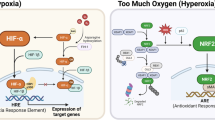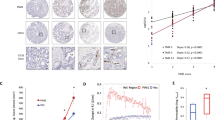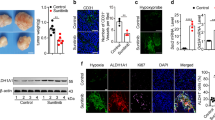Abstract
Cells exposed to low-oxygen conditions (hypoxia) alter their metabolism to survive. This response, although vital during development and high-altitude survival, is now known to be a major factor in the selection of cells with a transformed metabolic phenotype during tumorigenesis. It is thought that hypoxia-selected cells have increased invasive capacity and resistance to both chemo- and radiotherapies, and therefore represent an attractive target for antitumor therapy. Hypoxia inducible factors (HIFs) are responsible for the majority of gene expression changes under hypoxia, and are themselves controlled by the oxygen-sensing HIF prolyl hydroxylases (PHDs). It was previously shown that mutations in succinate dehydrogenase lead to the inactivation PHDs under normoxic conditions, which can be overcome by treatment with α-ketoglutarate derivatives. Given that solid tumors contain large regions of hypoxia, the reactivation of PHDs in these conditions could induce metabolic catastrophe and therefore prove an effective antitumor therapy. In this report we demonstrate that derivatized α-ketoglutarate can be used as a strategy for maintaining PHD activity under hypoxia. By increasing intracellular α-ketoglutarate and activating PHDs we trigger PHD-dependent reversal of HIF1 activation, and PHD-dependent hypoxic cell death. We also show that derivatized α-ketoglutarate can permeate multiple layers of cells, reducing HIF1α levels and its target genes in vivo.
This is a preview of subscription content, access via your institution
Access options
Subscribe to this journal
Receive 50 print issues and online access
$259.00 per year
only $5.18 per issue
Buy this article
- Purchase on Springer Link
- Instant access to full article PDF
Prices may be subject to local taxes which are calculated during checkout







Similar content being viewed by others
References
Aebersold DM, Burri P, Beer KT, Laissue J, Djonov V, Greiner RH et al. (2001). Expression of hypoxia-inducible factor-1alpha: a novel predictive and prognostic parameter in the radiotherapy of oropharyngeal cancer. Cancer Res 61: 2911–2916.
Appelhoff RJ, Tian YM, Raval RR, Turley H, Harris AL, Pugh CW et al. (2004). Differential function of the prolyl hydroxylases PHD1, PHD2, and PHD3 in the regulation of hypoxia-inducible factor. J Biol Chem 279: 38458–38465.
Aragones J, Schneider M, Van Geyte K, Fraisl P, Dresselaers T, Mazzone M et al. (2008). Deficiency or inhibition of oxygen sensor Phd1 induces hypoxia tolerance by reprogramming basal metabolism. Nat Genet 40: 170–180.
Berra E, Benizri E, Ginouves A, Volmat V, Roux D, Pouyssegur J . (2003). HIF prolyl-hydroxylase 2 is the key oxygen sensor setting low steady-state levels of HIF-1alpha in normoxia. EMBO J 22: 4082–4090.
Berra E, Roux D, Richard DE, Pouyssegur J . (2001). Hypoxia-inducible factor-1 alpha (HIF-1 alpha) escapes O(2)-driven proteasomal degradation irrespective of its subcellular localization: nucleus or cytoplasm. EMBO Rep 2: 615–620.
Birner P, Schindl M, Obermair A, Breitenecker G, Oberhuber G . (2001). Expression of hypoxia-inducible factor 1alpha in epithelial ovarian tumors: its impact on prognosis and on response to chemotherapy. Clin Cancer Res 7: 1661–1668.
Bishop T, Gallagher D, Pascual A, Lygate CA, de Bono JP, Nicholls LG et al. (2008). Abnormal sympathoadrenal development and systemic hypotension in PHD3−/− mice. Mol Cell Biol 28: 3386–3400.
Bracken CP, Whitelaw ML, Peet DJ . (2003). The hypoxia-inducible factors: key transcriptional regulators of hypoxic responses. Cell Mol Life Sci 60: 1376–1393.
Brahimi-Horn MC, Chiche J, Pouyssegur J . (2007). Hypoxia and cancer. J Mol Med 85: 1301–1307.
Brown JM, Wilson WR . (2004). Exploiting tumour hypoxia in cancer treatment. Nat Rev Cancer 4: 437–447.
Bruick RK, McKnight SL . (2001). A conserved family of prolyl-4-hydroxylases that modify HIF. Science 294: 1337–1340.
Chandel NS, Simon MC . (2008). Hypoxia-inducible factor: roles in development, physiology, and disease. Cell Death Differ 15: 619–620.
Epstein AC, Gleadle JM, McNeill LA, Hewitson KS, O’Rourke J, Mole DR et al. (2001). C. elegans EGL-9 and mammalian homologs define a family of dioxygenases that regulate HIF by prolyl hydroxylation. Cell 107: 43–54.
Erler JT, Cawthorne CJ, Williams KJ, Koritzinsky M, Wouters BG, Wilson C et al. (2004). Hypoxia-mediated down-regulation of Bid and Bax in tumors occurs via hypoxia-inducible factor 1-dependent and -independent mechanisms and contributes to drug resistance. Mol Cell Biol 24: 2875–2889.
Fukuda R, Zhang H, Kim JW, Shimoda L, Dang CV, Semenza GL . (2007). HIF-1 regulates cytochrome oxidase subunits to optimize efficiency of respiration in hypoxic cells. Cell 129: 111–122.
Gao P, Zhang H, Dinavahi R, Li F, Xiang Y, Raman V et al. (2007). HIF-dependent antitumorigenic effect of antioxidants in vivo. Cancer Cell 12: 230–238.
Goldberg MA, Gaut CC, Bunn HF . (1991). Erythropoietin mRNA levels are governed by both the rate of gene transcription and posttranscriptional events. Blood 77: 271–277.
Hewitson KS, Lienard BM, McDonough MA, Clifton IJ, Butler D, Soares AS et al. (2007). Structural and mechanistic studies on the inhibition of the hypoxia-inducible transcription factor hydroxylases by tricarboxylic acid cycle intermediates. J Biol Chem 282: 3293–3301.
Hirsila M, Koivunen P, Gunzler V, Kivirikko KI, Myllyharju J . (2003). Characterization of the human prolyl 4-hydroxylases that modify the hypoxia-inducible factor. J Biol Chem 278: 30772–30780.
Hu CJ, Sataur A, Wang L, Chen H, Simon MC . (2007). The N-terminal transactivation domain confers target gene specificity of hypoxia-inducible factors HIF-1alpha and HIF-2alpha. Mol Biol Cell 18: 4528–4542.
Huang J, Zhao Q, Mooney SM, Lee FS . (2002). Sequence determinants in hypoxia-inducible factor-1alpha for hydroxylation by the prolyl hydroxylases PHD1, PHD2, and PHD3. J Biol Chem 277: 39792–39800.
Ikeda E . (2005). Cellular response to tissue hypoxia and its involvement in disease progression. Pathol Int 55: 603–610.
Isaacs JS, Jung YJ, Mole DR, Lee S, Torres-Cabala C, Chung YL et al. (2005). HIF overexpression correlates with biallelic loss of fumarate hydratase in renal cancer: novel role of fumarate in regulation of HIF stability. Cancer Cell 8: 143–153.
Ivan M, Kondo K, Yang H, Kim W, Valiando J, Ohh M et al. (2001). HIFalpha targeted for VHL-mediated destruction by proline hydroxylation: implications for O2 sensing. Science 292: 464–468.
Jiang BH, Rue E, Wang GL, Roe R, Semenza GL . (1996). Dimerization, DNA binding, and transactivation properties of hypoxia-inducible factor 1. J Biol Chem 271: 17771–17778.
Khatua S, Peterson KM, Brown KM, Lawlor C, Santi MR, LaFleur B et al. (2003). Overexpression of the EGFR/FKBP12/HIF-2alpha pathway identified in childhood astrocytomas by angiogenesis gene profiling. Cancer Res 63: 1865–1870.
Kim JW, Tchernyshyov I, Semenza GL, Dang CV . (2006). HIF-1-mediated expression of pyruvate dehydrogenase kinase: a metabolic switch required for cellular adaptation to hypoxia. Cell Metab 3: 177–185.
Knowles HJ, Raval RR, Harris AL, Ratcliffe PJ . (2003). Effect of ascorbate on the activity of hypoxia-inducible factor in cancer cells. Cancer Res 63: 1764–1768.
Koivunen P, Hirsila M, Remes AM, Hassinen IE, Kivirikko KI, Myllyharju J . (2007). Inhibition of hypoxia-inducible factor (HIF) hydroxylases by citric acid cycle intermediates: possible links between cell metabolism and stabilization of HIF. J Biol Chem 282: 4524–4532.
Lee S, Nakamura E, Yang H, Wei W, Linggi MS, Sajan MP et al. (2005). Neuronal apoptosis linked to EglN3 prolyl hydroxylase and familial pheochromocytoma genes: developmental culling and cancer. Cancer Cell 8: 155–167.
Lu H, Dalgard CL, Mohyeldin A, McFate T, Tait AS, Verma A . (2005). Reversible inactivation of HIF-1 prolyl hydroxylases allows cell metabolism to control basal HIF-1. J Biol Chem 280: 41928–41939.
MacKenzie ED, Selak MA, Tennant DA, Payne LJ, Crosby S, Frederiksen CM et al. (2007). Cell-permeating alpha-ketoglutarate derivatives alleviate pseudohypoxia in succinate dehydrogenase-deficient cells. Mol Cell Biol 27: 3282–3289.
Maxwell PH, Dachs GU, Gleadle JM, Nicholls LG, Harris AL, Stratford IJ et al. (1997). Hypoxia-inducible factor-1 modulates gene expression in solid tumors and influences both angiogenesis and tumor growth. Proc Natl Acad Sci USA 94: 8104–8109.
Maxwell PH, Pugh CW, Ratcliffe PJ . (2001). Activation of the HIF pathway in cancer. Curr Opin Genet Dev 11: 293–299.
Maxwell PH, Wiesener MS, Chang GW, Clifford SC, Vaux EC, Cockman ME et al. (1999). The tumour suppressor protein VHL targets hypoxia-inducible factors for oxygen-dependent proteolysis. Nature 399: 271–275.
Papandreou I, Cairns RA, Fontana L, Lim AL, Denko NC . (2006). HIF-1 mediates adaptation to hypoxia by actively downregulating mitochondrial oxygen consumption. Cell Metab 3: 187–197.
Rofstad EK . (2000). Microenvironment-induced cancer metastasis. Int J Radiat Biol 76: 589–605.
Schlisio S, Kenchappa RS, Vredeveld LC, George RE, Stewart R, Greulich H et al. (2008). The kinesin KIF1Bbeta acts downstream from EglN3 to induce apoptosis and is a potential 1p36 tumor suppressor. Genes Dev 22: 884–893.
Schofield CJ, Ratcliffe PJ . (2004). Oxygen sensing by HIF hydroxylases. Nat Rev Mol Cell Biol 5: 343–354.
Selak MA, Armour SM, MacKenzie ED, Boulahbel H, Watson DG, Mansfield KD et al. (2005). Succinate links TCA cycle dysfunction to oncogenesis by inhibiting HIF-alpha prolyl hydroxylase. Cancer Cell 7: 77–85.
Semenza GL . (2000). HIF-1: mediator of physiological and pathophysiological responses to hypoxia. J Appl Physiol 88: 1474–1480.
Semenza GL . (2001). Hypoxia-inducible factor 1: oxygen homeostasis and disease pathophysiology. Trends Mol Med 7: 345–350.
Semenza GL . (2003). Targeting HIF-1 for cancer therapy. Nat Rev Cancer 3: 721–732.
Simon MC, Keith B . (2008). The role of oxygen availability in embryonic development and stem cell function. Nat Rev Mol Cell Biol 9: 285–296.
Talks KL, Turley H, Gatter KC, Maxwell PH, Pugh CW, Ratcliffe PJ et al. (2000). The expression and distribution of the hypoxia-inducible factors HIF-1alpha and HIF-2alpha in normal human tissues, cancers, and tumor-associated macrophages. Am J Pathol 157: 411–421.
Taylor MS . (2001). Characterization and comparative analysis of the EGLN gene family. Gene 275: 125–132.
To KK, Koshiji M, Hammer S, Huang LE . (2005). Genetic instability: the dark side of the hypoxic response. Cell Cycle 4: 881–882.
Wang GL, Jiang BH, Rue EA, Semenza GL . (1995). Hypoxia-inducible factor 1 is a basic-helix-loop-helix-PAS heterodimer regulated by cellular O2 tension. Proc Natl Acad Sci USA 92: 5510–5514.
Williamson JR, Corkey BE . (1979). Assay of citric acid cycle intermediates and related compounds—update with tissue metabolite levels and intracellular distribution. Methods Enzymol 55: 200–222.
Yoon D, Pastore YD, Divoky V, Liu E, Mlodnicka AE, Rainey K et al. (2006). Hypoxia-inducible factor-1 deficiency results in dysregulated erythropoiesis signaling and iron homeostasis in mouse development. J Biol Chem 281: 25703–25711.
Acknowledgements
This work was supported by Cancer Research UK and the Association for International Cancer Research. We thank Tom Hamilton and Derek Miller for their invaluable assistance with the in vivo work, Colin Nixon and Mairi Macdonald for helping with the histology, Margaret O’Prey for help with the microscopy, Celeste Simon for generously providing us with the HIF1α-expressing plasmid and Ayala King for her excellent editorial work.
Author information
Authors and Affiliations
Corresponding author
Rights and permissions
About this article
Cite this article
Tennant, D., Frezza, C., MacKenzie, E. et al. Reactivating HIF prolyl hydroxylases under hypoxia results in metabolic catastrophe and cell death. Oncogene 28, 4009–4021 (2009). https://doi.org/10.1038/onc.2009.250
Received:
Revised:
Accepted:
Published:
Issue Date:
DOI: https://doi.org/10.1038/onc.2009.250
Keywords
This article is cited by
-
Cigarette smoke causes a bioenergetic crisis in RPE cells involving the downregulation of HIF-1α under normoxia
Cell Death Discovery (2023)
-
Oncometabolites in renal cancer
Nature Reviews Nephrology (2020)
-
Restraining colorectal cancer with αKG
Nature Cancer (2020)
-
Intrabody against prolyl hydroxylase 2 promotes angiogenesis by stabilizing hypoxia-inducible factor-1α
Scientific Reports (2019)
-
Inducing cancer indolence by targeting mitochondrial Complex I is potentiated by blocking macrophage-mediated adaptive responses
Nature Communications (2019)



